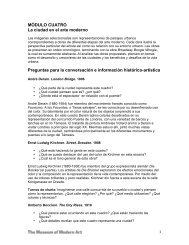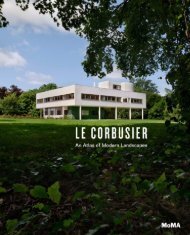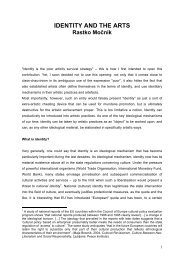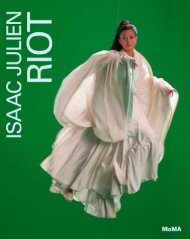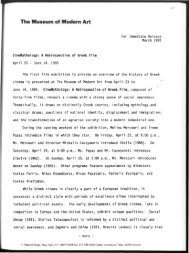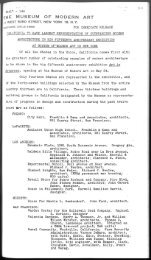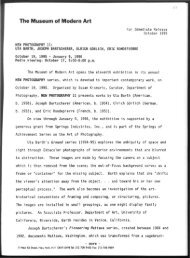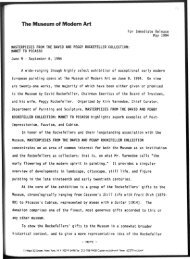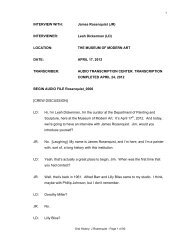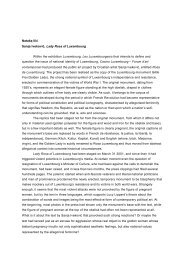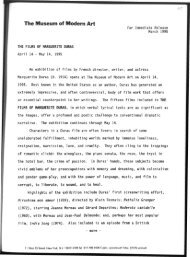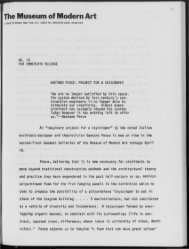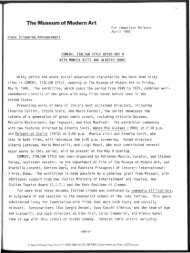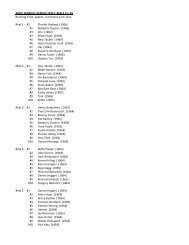Download free sample - MoMA
Download free sample - MoMA
Download free sample - MoMA
You also want an ePaper? Increase the reach of your titles
YUMPU automatically turns print PDFs into web optimized ePapers that Google loves.
c o n t e n t s<br />
6<br />
Foreword<br />
Glenn D. Lowry<br />
8<br />
Acknowledgments<br />
10<br />
The Manic DeparTMenT STore<br />
New Perspectives on the Quay Brothers<br />
Ron Magliozzi<br />
16<br />
ThoSe Who DeSire WiThouT enD<br />
Animation as “Bachelor Machine”<br />
Edwin Carels<br />
21<br />
on Deciphering<br />
The pharMaciST’S preScripTion<br />
for Lip-reaDing puppeTS<br />
A project by the Quay Brothers<br />
28<br />
pLaTeS<br />
62<br />
Works by the Quay Brothers<br />
63<br />
Selected Bibliography<br />
64<br />
Trustees of The Museum of Modern Art<br />
The book also contains a project by the Quay Brothers on the front and back inside covers.
Ron Magliozzi<br />
The<br />
Manic<br />
DeparTMenT<br />
STore<br />
New<br />
Perspectives on the<br />
Quay Brothers<br />
Sometimes it shocks us how few references people<br />
have to the literature and music that has driven<br />
us . . . . It makes us feel elitist by default, which is<br />
not what we intend. We would rather our films were<br />
treated like department stores — admittedly manic<br />
department stores — in which one can take a lift<br />
to whatever level one wants.<br />
THE QuAy BROTHERS, 1986 1<br />
It is gratifying to report, right at the start, that the<br />
reputed inaccessibility of the Quay Brothers’ work is a<br />
myth. The challenge of deciphering meaning and narrative<br />
in the roughly thirty theatrical shorts and two features<br />
that the filmmakers have produced since 1979 is real<br />
indeed, a characteristic of their work that they adopted<br />
on principle when they were still students. Interpreters of<br />
their stop-motion puppet films, such as the defining Street<br />
of Crocodiles (1986), have described them as alchemists,<br />
with the mystifying ability to turn the “degraded reality”<br />
of discarded doll parts, screws, string, and metal filings<br />
into profoundly expressive characters, and as metaphysicians,<br />
whose choreography of objects and camera<br />
movement in space is key to understanding their<br />
uncanny sense of being. And as Surrealists — although<br />
the twins disclaim the label — who stage playful, perplexing,<br />
life-and-death scenarios within wondrous,<br />
handmade sets and across dreamlike landscapes. The<br />
Quay Brothers themselves, valuing their independence<br />
from the culture of commercial cinema, identify most<br />
comfortably with those alienated from their age, like<br />
the writers Bruno Schulz, Robert Walser, and Franz<br />
Kafka, whom they have favored in their work, and<br />
with genuinely obsessive personalities like Emma<br />
Hauck and Adolf Wölfli, who created from behind<br />
hospital and prison walls.<br />
To the degree that they have controlled others’<br />
access to the full record of their creative lives,<br />
including fifteen years working primarily as<br />
graphic illustrators, the Quay Brothers have further<br />
confounded understanding of their work. A<br />
double self-portrait as gnomish Mennonites may<br />
be a clue to the spirit of play that motivates them,<br />
as might the multiple ways in which the identical<br />
twins Stephen and Timothy have signed their<br />
work: Brothers Quay, Gebr. Quaij, Stíofáin Valtair<br />
MacAae. Or for that matter, their studio name,<br />
KonincK, chosen for its typographical symmetry<br />
from the label of a Belgian beer. As much as<br />
they welcome scholarly analysis, for some time<br />
they resisted full disclosure by spreading the<br />
fanciful report that all their early films before<br />
Nocturna Artificialia: Those Who Desire Without<br />
End (1979) had been lost. 2 Such strategies have<br />
served to maintain the privacy that has nourished<br />
the solipsistic nature of their collaborative<br />
practice — working alone together nearly<br />
every day — for over forty years. They have<br />
also effectively limited the revealing connections<br />
that might be made between their personal<br />
history and the various mediums and<br />
genres in which they’ve worked.<br />
As illustrators, stage designers, and filmmakers<br />
in a range of genres, the Quays have<br />
penetrated many fields of visual expression<br />
for a number of different audiences, from<br />
avant-garde cinema and opera to publication<br />
art and television advertising. Looking at<br />
their artistic endeavors as a whole, in the<br />
context of fresh biographical information and<br />
new evidence of their creativity, provides<br />
insight into the roots of their imagination and<br />
illuminates a number of essential Quay themes<br />
and motifs.<br />
The Quay Brothers were born in 1947 in<br />
Norristown, Pennsylvania, a borough fifteen<br />
miles northwest of Philadelphia on the<br />
Schuylkill River. Once a manufacturing center<br />
for “tacks, wire, screws, boilers, bolts, silos,<br />
tanks, iron, hosiery, knitting machines, underwear,<br />
shirts, lumber and milling machinery,” by<br />
the 1950s it was no longer an industrial hub but<br />
remained the center of social life for the surrounding<br />
rural area. 3 Their father was a first-class<br />
machinist; their mother — to whom the twins bear<br />
an uncanny physical resemblance — was a homemaker<br />
with a talent for figure skating. Tall, sound<br />
of body, and agile, the twins considered sports as<br />
a life option. In the Mist (c. 1969), one of their amateur<br />
films, is a revealing self-portrait of the athletic<br />
teenagers, in oversized paper masks, performing a<br />
series of comic running and cycling stunts on grass<br />
and in a vacant tennis court. A celebration of their<br />
“twin-ness,” it displays some of the avant-garde image-<br />
ry that appears in later work: the flat, cut-out paper<br />
face they give their composer doll in Leoš Janáček:<br />
Intimate Excursions (1983), the vacant, surreal<br />
landscape that introduces In Absentia (2000), and<br />
the mystifying, rootless trees that suggest the sleepinduced<br />
fairy-tale world of The Comb [From the<br />
Museums of Sleep] (1990).<br />
One influence on the brothers’ choice of art over<br />
sport may be found in their exposure to the thriving<br />
culture of the local flea markets: suburban “cabinets<br />
of curiosity” stocked with the kind of dusty, decaying<br />
objects redolent with textures, the call to touch, and<br />
secret past lives that would become the stuff of their<br />
films. Later, on Portobello Road in London, they<br />
encountered a similar milieu: “you find these dolls’<br />
heads in a market . . . you live with these things . . . you<br />
dream yourself into them.” 4 They described their search<br />
for artistic inspiration in similar terms: “At worst we<br />
think of ourselves as rummaging for lost or obscure footnotes<br />
in half-forgotten alleys of music and literature.” 5<br />
The twins’ “facility for drawing” 6 was encouraged by<br />
their family. At home, snowy pastoral landscapes of a<br />
red barn at different distances were hung side by side,<br />
coincidentally suggesting a cinema tracking shot. Stark<br />
countryside landscapes dotted with trees appeared<br />
commonly in their youthful drawings, often with elements<br />
of telling human interest, as in Bicycle Course for<br />
Aspiring Amputees (1969) and Fantasy-Penalty for<br />
Missed Goal (c.1968). The Quays later remarked that<br />
the only “residue” of life in Pennsylvania to affect their<br />
work was “the forest and the animals.” 7 But it was their<br />
art teacher’s introduction to illustrator and naturalist<br />
Rudolf Freund (1915 –1969), who lived twenty miles<br />
away in Collegeville, Pennsylvania, that transformed<br />
the twins’ sense of the world and art. 8 Renowned for<br />
his Scientific American covers and his art for Time-<br />
Life, Freund had been thinking of a school for illustrators<br />
on his farm. 9 He allowed the twins to observe<br />
him at his easel and to study what they described as<br />
“the kingdom of animals and insects” in his library. 10<br />
The ecological subtext in a number of the Quays’<br />
films may be traced to Freund’s influence, as some<br />
of his assignments, such as the Scientific American<br />
cover illustrations Mouse in a Metabolism Cage<br />
(November 1956) and Chicken Factory (July 1966),<br />
called for the illustration of darker themes. The<br />
twins were impressed by Freund’s meticulous anatomical<br />
research and the luminescent detail in his<br />
lifelike art. Having watched him working on the<br />
Scientific American cover image Ecological<br />
Chemistry (fig. 1, February 1969), a painting of a<br />
blue jay choosing between identical living and<br />
dead butterflies, they later described the experience<br />
as “one of those crucial revelatory moments<br />
when something painted was so powerfully<br />
tactile.” 11 Their experiences with Freund fathered<br />
many of the twins’ aesthetic principles and<br />
provided a model for their consuming work ethic.<br />
Expressing the depth of their respect years later,<br />
they favorably compared “the care, the patience,<br />
the craftsmanship and caliber” of Freund’s<br />
scientific illustration to the “serious illustration”<br />
of “Bonnard, Dulac, Redon, Rackham etc.” 12<br />
In 1965, at the age of eighteen, the Quay<br />
Brothers began seven years of study to<br />
become illustrators, graduating from the<br />
Philadelphia College of Art (PCA) in 1969 and<br />
London’s Royal College of Art (RCA) in 1972.<br />
During this period, two fateful encounters<br />
introduced them to the visual language<br />
and European subjects they would quickly<br />
adopt, and to the medium of film they would<br />
10 11
12<br />
Fig. 2 Roman Cieslewicz<br />
(French, born Poland.<br />
1930–1996). Katastrofa.<br />
1961. Poland. Film poster,<br />
33 1 ⁄8 × 23 3 ⁄16” (84.1 ×<br />
58.9 cm). The Museum of<br />
Modern Art, New York<br />
Fig. 3 Watermark.<br />
Joseph Brodsky.<br />
c. 1983–1984. UK.<br />
Collage, 11 × 7 3 ⁄4”<br />
(27.9 × 19.7 cm).<br />
QBFZ Collection<br />
Fig. 1 Rudolf Freund.<br />
“Ecological Chemistry”<br />
(Blue Jay and<br />
Butterflies), cover for<br />
Scientific American,<br />
February 1969. U.S.A.<br />
11 1 ⁄2 × 8 3 ⁄8” (29.2 ×<br />
21.3 cm). The Museum of<br />
Modern Art, New York<br />
eventually take up. It wasn’t simply the radical design of<br />
the Polish posters that they came upon by chance in an<br />
exhibition at the PCA, or the posters’ revelation of a foreign<br />
world of European opera, drama, music, and cinema<br />
that irresistibly attracted them — it was the fact<br />
that the posters spoke so <strong>free</strong>ly of their subjects, as if<br />
consuming them. 13 The grotesque, surreal, lyrical, and<br />
witty work of Roman Cie´slewicz (1930 –1996), Wojciech<br />
Fangor (1922– ), Jan Lenica (1928 –2001), Franciszek<br />
Starowieyski (1930 –2009), Henryk Tomaszewski<br />
(1914 –2005), Wojciech Zamecznik (1923 – ), and<br />
Bronislaw Zelek (1935 – ) was illustration art with the<br />
courage to be strange and ambiguous. If one compares<br />
the cityscape motif in Cie´slewicz’s poster<br />
Katastrofa (fig. 2, 1961) to the Quays’ Duet Emmo album<br />
cover (1983) and to their art for Joseph Brodsky’s<br />
Watermark (fig. 3, c. 1983 – 84), the influence is apparent;<br />
it may also be detected in the maps and visual<br />
textures of Street of Crocodiles. The Quays’ first professional<br />
job came shortly after, in their last year at<br />
the PCA: the design of an album cover for American<br />
rock band Blood, Sweat & Tears in 1968. Already<br />
committed to the Polish poster aesthetic, they submitted<br />
a collage of the group standing headless in a<br />
field. To their chagrin, Columbia Records responded<br />
by “pasting” heads onto their illustration.<br />
Compounding the impact of the Polish avantgarde,<br />
the cinema further matured the Quays’ aesthetic.<br />
They credit Luis Buñuel’s Un Chien Andalou<br />
(1929) as the first film to seriously impress them, 14<br />
as attested by a drawing from their RCA days,<br />
which pictures male torsos tattooed with the<br />
words Un Chien Andalou and L’Age d’or, the title<br />
of a second Buñuel film (1930). However, it is the<br />
experimental shorts of Walerian Borowczyk<br />
(1923 – 2006) and Jan Lenica, which the Quays<br />
describe as “animation at its most intense, mysterious<br />
and metaphoric,” 15 that most explicitly<br />
point the way to the films they would make<br />
themselves. 16 The mix of collage, stop-motion,<br />
live-action, and trick effects combined with<br />
eroticism and weighty subjects would become<br />
a Quay signature. The stop-motion reassembly<br />
of exploded household items in Borowczyk’s<br />
Renaissance (1963) speaks to the Quays’ fascination<br />
with the drama of real objects. In his<br />
Holocaust allegory Jeux des Anges (1964),<br />
camera movement and sound impart meaning<br />
to drawings of dismemberment. Une<br />
Collection Particulière (1973), Borowczyk’s<br />
study of nineteenth-century pornographic<br />
devices, is a model for the Quays’ museum<br />
documentaries The Phantom Museum (2003),<br />
Inventorium of Traces (2009), and Through<br />
the Weeping Glass (2011). 17 With Goto L’île<br />
d’Amour, a 1971 collage titled after<br />
Borowczyk’s first feature, they visualized an<br />
extended narrative for the film. 18 As they<br />
explained the influence in 1973: “We both<br />
draw too much from cinema and pretend that<br />
when we are illustrating, we are really animating<br />
— composing films with musique [sic] only<br />
back into still pictures.” 19<br />
In an RCA student publication to which the<br />
Quays contributed — along with illustrators<br />
Eduardo Paolozzi, Andrzej Klimowski, and<br />
Stewart Mackinnon, who eventually made films<br />
as well — the effect of the group’s exposure to<br />
avant-garde image-making was stated defiantly<br />
by Mackinnon: “true expression conceals what it<br />
exhibits . . . an image, an allegory, a form disguising<br />
what it means to reveal, has more meaning<br />
than the enlightenment brought about by words<br />
or their analysis.” 20 The Quays’ student films demonstrated<br />
their commitment to this manifesto.<br />
Each is a tragic allegory, shy of narrative clarity,<br />
with enticing hints at twin-ness and veiled autobiography.<br />
Der Loop Der Loop (1971), Il Duetto<br />
(1971), Palais en Flammes (1972), and an uncompleted<br />
de Sade project were clearly the work of<br />
illustrators: paper cut-out animation based on<br />
ideas begun as drawings. When the Quays made<br />
them, illustration was still the career they were set<br />
to pursue.<br />
Returning to the united States in 1973, they<br />
described a range of simmering influences, “. . . from<br />
Alice in Wonderland to Kafka’s In Der Strafkolonie to<br />
Rudolf Freund’s scientific illustrations for Time-Life.<br />
From a film version of Knut Hamsun’s Hunger to the<br />
music of Debussy’s for Maeterlinck’s Pelléas et<br />
Mélisande; from Nino Rota’s film music for Fellini to<br />
Giovanni Fusco’s . . . for Antonioni and Maurice Jarre’s<br />
. . . for Franju. From the self-portraits of Ensor, Bonnard<br />
and van Gogh to the autobiographies of Truffaut,<br />
Céline, Vigo, Skolimowski. From Resnais’ Nuit et<br />
Brouillard to Marker’s La Jetée. From de Sade, to Kraft-<br />
Ebbing to Buñuel.” 21 But over the next six years in<br />
Philadelphia and Amsterdam their illustration work<br />
was sporadic and unfulfilling: filler for the New York<br />
Times music review; a black drawing titled “I Am an<br />
Epileptic” for the Philadelphia Inquirer; book covers for<br />
suspense and science-fiction novels; and suitably gothic<br />
drawings on surgery and cattle mutilation for Hugh<br />
Hefner’s men’s magazines. 22 Their most prestigious work<br />
in the united States was for the Anthony Burgess novel A<br />
Clockwork Testament or Enderby’s End (1975), a dozen<br />
black-and-white drawings of the title character in stages<br />
of disintegration. Illustrator Andrzej Klimowski<br />
remarked sympathetically that “[this] series of portraits<br />
. . . will always remain distant . . . can only remain<br />
impenetrable despite all signs of introspection.” 23 The<br />
Quays’ most sustained work as illustrators was the<br />
series of covers done for the Dutch and British editions<br />
of authors Louis-Ferdinand Céline and Italo<br />
Calvino, featuring variations of the figurative “extinct<br />
anatomies” and noir graphics that would surface most<br />
expressively in their films.<br />
Disappointments aside, throughout this period<br />
the twins experimented with graphics and nurtured<br />
their growing enthusiasm for avant-garde drama and<br />
music through hypothetical designs for posters,<br />
books, and record albums. This “fictitious” work<br />
included gymnastic autoerotica for Mishima (c.<br />
1971), tortured anatomy studies for Ul Abnormalna<br />
(c. 1981–82), and several Enzyklopedie der Modernen<br />
Kriminalistik credited to obscure nineteenth-century<br />
criminologists; faux theater posters for the<br />
work of German-language playwrights, such as<br />
Thomas Bernard’s Der Ignorant und der Wahnsinnige<br />
(c. 1981–82), Peter Handke’s Kaspar (n.d.),<br />
Friedrich Dürrenmatt’s Die Physiker (c. 1981–82),<br />
and Hartmut Lange’s Der Hundsprozess (n.d.), in<br />
which dog heads are attached to decapitated<br />
bodies. They also made a Portrait of Composer<br />
Gesualdo (c. 1976), known for his highly expressive<br />
sacred music and for having murdered his<br />
adulterous wife and her lover in 1590. In 1981,<br />
two years into their professional filmmaking<br />
career, the twins were still identified primarily as<br />
graphic artists, appearing in the “Radical<br />
Illustrators” issue of the British Illustrators magazine,<br />
among a fellowship of others whose<br />
styles, from Sue Coe’s neo-expressionism to<br />
Terry Dowling’s anticommercial proto-punk,<br />
reflected various degrees of militancy against<br />
the mainstream. 24<br />
Whatever militancy the Quays felt, they<br />
expressed their frustrations most profoundly<br />
in private, at the easel, with illustration<br />
“reserved in deep shadow (the works . . . we<br />
put ourselves into).” 25 In a series of more than<br />
a dozen pieces called The Black Drawings (c.<br />
1970s) they defined the visual palette of their<br />
future films, creating an ur-text that they<br />
would return to as well in opera and ballet<br />
settings such as those for Mazeppa (1991)<br />
13
and The Sandman (2000). Titled with<br />
obscure references to French wine, electroshock,<br />
sports, Holocaust history, Kafka,<br />
Céline, 26 and their own travels in Europe, the<br />
drawings are noir set pieces, each with the<br />
requisite blend of angst, sex, and violence;<br />
they read like crime scenes glimpsed from a<br />
passing tram. The earliest puppet films,<br />
Nocturna Artificialia and the Kafka adaptation<br />
Ein Brudermord (1980), created with producer<br />
Keith Griffiths, come directly from the drawings.<br />
27 The influence is still strong in the brothers’<br />
film noir reading of Stanisław Lem’s Maska<br />
(2010). The black may derive from illustration<br />
— the intaglio technique that the twins had<br />
always admired 28 — but the figurative use of suspended<br />
gestures and “privileged point of view”<br />
is cinematic. 29 The Black Drawings mark the<br />
point at which the twins were ready to step away<br />
from illustration and begin to identify themselves<br />
as the poets of gesture and alienation they<br />
would remain in every medium they touched.<br />
In the 1980s graphic art became a sidebar as<br />
the Quays gradually turned to filmmaking fulltime,<br />
but they brought to the moving image significant<br />
visual motifs initially explored on paper. The elegant<br />
line and lettering of calligraphy is an enduring<br />
element in their work, from their business cards<br />
and book and album covers to the wrought-iron<br />
calligraphy of their studio logo, their posters, and<br />
the credit sequences in their films. It is celebrated<br />
in The Calligrapher (1991), memorialized in In<br />
Absentia, 30 and figures significantly in the design of<br />
their sets for The Cabinet of Jan Švankmajer (1984),<br />
This Unnameable Little Broom (1985), Rehearsals for<br />
Extinct Anatomies (1987), and the music video Long<br />
Way Down (1992). 31 Calligraphy’s lyrical, sweeping<br />
gesture and elegant symmetry map movement across<br />
the page, musicalizing space, the way the movement<br />
of the camera, lighting, objects, and performers are<br />
used in the Quays’ films. The notion of calligraphy<br />
extends to the choreographic quality of their films,<br />
which, like music, often serves as an “unwritten<br />
scenario” of gestures. No wonder their ballet films<br />
Duet (1999), a return to the theme of twin-ness, and<br />
The Sandman (2000), which revisits the expressionism<br />
of The Comb, are so masterful. Recognizing this motivating<br />
principle is essential to appreciating their films,<br />
be it the choreographed decapitation of the hero in<br />
Street of Crocodiles or the uncanny pas de deux of<br />
mannequin and rabbit in Stille Nacht II: Are We Still<br />
Married? (1992).<br />
Scholars have noted the connection between the<br />
themes of “interior and exterior space” and “closure and<br />
exploration” in the Quays’ films; these motifs are present<br />
in their two-dimensional work as well. 32 Rural landscapes<br />
are the subject of many of their early paintings<br />
(The Painted Bird, 1967), albums (Blood, Sweat & Tears,<br />
1968; Mozart Violin Concerto No. 2, c. 1973), and books<br />
(the Calvino series), as well as the more theatrically<br />
inclined Black Drawings. Here, as in films like In<br />
Absentia and The Comb, these are ill-defined places,<br />
without sunshine — closer to the existential “dustbreeding”<br />
ground of Duchamp and Man Ray’s Élevage<br />
de Poussière than the bright edgy landscapes of<br />
Tanguy or Dalí. 33 Complementing the Quays’ depictions<br />
of exteriors, a number of early drawings<br />
— including one titled Kafka’s The Dream<br />
(1970) — feature views from inside, with glimpses out<br />
through open doorways and windows. What on<br />
paper resemble static stage settings on film become<br />
claustrophobic interiors, where inscrutable dramas<br />
play out. The beloved Pennsylvania woods become<br />
metaphorical furniture — reduced to fetishized pine<br />
cones and wood grain in Stille Nacht III: Tales from<br />
Vienna Woods (1992) and the commercial<br />
Wonderwood (2010) — or moved indoors, as the forest<br />
invades the composer’s room in Leoš Janáček:<br />
Intimate Excursions. The troubled explorations<br />
that occur through rooms and streets in Street of<br />
Crocodiles and Rehearsals for Extinct Anatomies<br />
are allegories for the chaos of the human condition.<br />
Quay protagonists exist inside hermetic,<br />
unstable spaces, each with a secret history, populated<br />
with the fertile refuse of flea markets.<br />
Outside, there may be a landscape of dream (The<br />
Comb) or a view of the void (This Unnameable<br />
Little Broom).<br />
In recent years the Quays have replicated<br />
their visionary rooms for gallery display as the<br />
boxes of Dormitorium (2006) and a peephole<br />
installation, Coffin of a Servant’s Journey<br />
(2007). 34 Again, they adapted their challenging<br />
aesthetic to a new medium, as they have previously<br />
done for classical and avant-garde drama,<br />
opera, ballet, site-specific performance, cinema,<br />
commercial television, and music video. 35<br />
In the process, they have added to the surprising<br />
variety of options available to viewers<br />
willing to enter the Quay Brothers’ “department<br />
store” and open themselves to uncertainty<br />
and the experience of strange new<br />
perspectives.<br />
1 Chris Petit, “Picked-up Pieces,” interview with the Quay<br />
Brothers, Monthly Film Bulletin 53 no. 629 (June 1986):164–65.<br />
Note that in virtually all interviews with the Quays, including<br />
this one, quotes are attributed to both brothers rather than<br />
either one individually.<br />
2 Hammond, Paul, “In Quay Animation,” Afterimage 13<br />
(Autumn 1987):66–67.<br />
3 “Norristown, Pennsylvania,” Wikipedia. http://en.wikipedia.<br />
org/wiki/Norristown,_Pennsylvania. In the 1940s, Norristown<br />
had a population of roughly 40,000; it is now approximately<br />
32,000.<br />
4 Kim Newman, “The doll’s house,” interview, City Limits<br />
(September 25, 1986):n.p. Museum of Modern Art, Film Study<br />
Center clipping file, Quay Brothers. In the interview for this<br />
London magazine, the Quays misidentified the Portobello Road<br />
market as Finchley Road, an error they corrected in an email to<br />
the author on February 23, 2012.<br />
5 Chris Petit, “Picked-Up Pieces.”<br />
6 “The Quay Brothers’ Perifere Blik” [Peripheral Vision], oncamera<br />
interview for the television program Ziggurat, BRTN<br />
(Belgian Television), July 1996.<br />
7 Teddy Jamieson, “Ten Questions for the Brothers Quay,” Herald<br />
Scotland June 22, 2010. http://www.heraldscotland.com/arts-ents/<br />
edinburgh-film-festival/ten-questions-for-the-brothers-quay-1.1036524<br />
8 Freund lived in Collegeville until an aneurism caused his sudden<br />
death at 54, shortly after the Quays entered the Royal Academy of<br />
Art. Freund illustrated more than thirty books and nature guides,<br />
including the Time Inc. Life Nature Library series, and created<br />
eighteen Scientific American covers from 1954 to 1969. A frequent<br />
contributor to Life magazine, his “Mythical Monsters” illustrations in<br />
the April 23, 1951, issue suggest that he would have been successful<br />
as a fantasy illustrator. As a naturalist, he was one of the first to<br />
explore the Galápagos Islands and later, with his wife Susan, the<br />
jungles of Suriname in South America in 1961, returning with specimens<br />
now held by the Yale Peabody Museum of Natural History.<br />
9 Email to the author from Susan Freund Borden, November 7, 2011.<br />
10 Email from the Quay Brothers to Sandy Borden, November 5, 2011.<br />
11 Ibid.<br />
12 Quay Brothers, “The Quay Twins in America,” ARK 51, Royal<br />
College of Art, London (Summer 1973):n.p. Italics in original.<br />
13 Polish Poster Art, presented April 1–27, 1967, at the Philadelphia<br />
College of Art.<br />
14 Jamieson, “Ten Questions,” Herald Scotland.<br />
15 Julian Petley, “Puppet masters,” interview, The Guardian (London),<br />
September 25, 1986. Museum of Modern Art, Film Study Center clipping<br />
file, Quay Brothers.<br />
16 The Quay Brothers are often paired with Czech Surrealist Jan<br />
Švankmajer, the subject of the 1984 documentary The Cabinet of Jan<br />
Švankmajer, to which they contributed an animation sequence that was<br />
later excerpted as a stand-alone short film of the same title. But the<br />
Quays discredit Švankmajer’s direct influence in this period because they<br />
had not as yet encountered his work. Instead, the Quays much admired the<br />
Borowczyk-Lenica collaboration Dom (1958) and Lenica’s Labyrinth (1961),<br />
and also acknowledge the influence of Soviet animator Yuri Norstein.<br />
17 The Quays’ music-box device Lacrimi Christi, created for their feature<br />
film The Piano Tuner of Earthquakes (2005) and included in the touring exhibition<br />
of their film decors that began in 2006, is an unspoken tribute to the<br />
flycatcher contraption that Borowczyk designed as a prop for his 1969<br />
feature film, Goto L’Ile d’Amour.<br />
18 Daniel Bird. “The Ghost of Goto: Walerian Borowczyk Remembered.”<br />
Vertigo, 3:1 (Spring 2006): 57–59.<br />
19 Quay Brothers, “The Quay Twins in America.”<br />
20 Stewart Mackinnon, “Manifesto,” ARK 51, Royal College of Art (1973):n.p.<br />
21 Quay Brothers, “The Quay Twins in America.”<br />
22 “The Night Surgeon, fiction by Robert Chatain,” Playboy 20: 11<br />
(November 1973):96–97; “On the Trail of the Night Surgeons by Ed<br />
Sanders,” Oui 6: 5 (May 1977):78–79.<br />
23 “The Work of Stephen and Timothy Quaij,” unidentified Soviet film<br />
publication, c. 1986. Museum of Modern Art, Film Study Center clipping file,<br />
Quay Brothers.<br />
24 “Koninck, Londyn: The Brothers Quay,” Illustrators (U.K.) 38 (1981),<br />
edited by George Snow and Robert Mason. Also featured in the issue:<br />
Edward Bell, Georgeanne Deen, Catherine Denvir, Blair Drawson, Robert<br />
Ellis, Carolyn Gowdy, Anne Howeson, Rod Judkins, Andrzej Klimowski,<br />
Stewart Mackinnon, Shinro Ohtake, Ian Pollock, Liz Pyle, Sol Robbins,<br />
Christine Roche, and Jake Tilson.<br />
25 Quay Brothers, “The Quay Twins in America.”<br />
26 Especially provocative are the sinister references to Céline’s anti-<br />
Semitic texts, Bagatelles pour un Massacre (1937) and L’Ecole des Cadavres<br />
(1938).<br />
27 British-born Keith Griffiths (1947– ) met the Quays at the Royal<br />
College of Art in London, where he was studying film. He soon became<br />
a close friend, traveling companion, and in 1979 co-founder of their<br />
Koninck Studios. As an executive at the British Film Institute<br />
Production Board in the early 1980s, he was instrumental in the<br />
Quays’ transition from illustration to film, and eventually shepherded<br />
most of their best-known work to the screen.<br />
28 “We’ve always liked . . . the intaglio technique because you work<br />
out of the black, you make things come from the black instead of<br />
creating the black.” “The Quay Brothers’ Perifere Blik.” Intaglio is a<br />
printmaking technique in which black ink completely covers an<br />
engraved or etched printing plate before being wiped away to reveal<br />
the outlines of the artist’s drawing beneath.<br />
29 “The Quay Brothers’ Perifere Blik.”<br />
30 It was the manic calligraphic quality of Emma Hauck’s letters<br />
that inspired the Quays to create this portrait of psychosis.<br />
31 The Quays have repurposed the miniature decors from their<br />
films as gallery exhibition pieces, which have toured since 2006 as the<br />
Dormitorium. The complete title of This Unnameable Little Broom is<br />
Little Songs of the Chief Officer of Hunar Louse, or This Unnameable Little<br />
Broom, being a Largely Disguised Reduction of the Epic of Gilgamesh.<br />
32 See Suzanne H. Buchan, “A Metaphysics of Space: The Quay<br />
Brothers’ Atmospheric Cosmogonies” in Lois Weinthal, ed.,<br />
Toward a New Interior: An Anthology of Interior Design Theory (New<br />
York: Princeton Architectural Press, 2011), 527–45; Jordi Costa,<br />
“The Quay Brothers, Explorers of Limbos,” in the catalogue for<br />
the 2001 Sitges International Film Festival, Sitges, Spain, 43–47.<br />
33 An otherworldly Dadaist collaboration by Man Ray and<br />
Marcel Duchamp, Élevage de Poussière (1920) is the photographic<br />
record of the layer of dust that accumulated on<br />
Duchamp’s sculpture The Bride Stripped Bare by Her Bachelors,<br />
Even (The Large Glass) (1915–23) over several months in 1920.<br />
34 The number of boxes in Dormitorium has varied with each<br />
installation, ranging up to two dozen.<br />
35 The Quays’ genre parodies for beer, snack food, and<br />
weed-killer reveal a sense of humor that they deny having, as<br />
well as their secret life as film buffs. Although commercials<br />
traditionally call for artistic compromise, the field has<br />
employed the talent of such esteemed filmmakers as Oscar<br />
Fischinger, Len Lye, and Alexandre Alexeieff and Claire Parker,<br />
whose work bears comparison to the Quays’.<br />
14 15<br />
NOTES
28<br />
1. Il Duetto. 1970. UK. Etching, 15 3 ⁄4 × 11 1 ⁄4"<br />
(40 × 28.6 cm). QBFZ Collection<br />
3. Self-Portrait as Mennonites. 1995. UK.<br />
Photographic print, 12 × 9"<br />
(30.5 × 22.9 cm). QBFZ Collection<br />
2. Untitled (Tattooed Men). c. 1970s. UK.<br />
Photolithograph, 9 3 ⁄4 × 11" (24.8 × 27.9 cm).<br />
Lydia Hunn Collection<br />
29
10. Book cover for<br />
Zamyatin. c. 2000. UK.<br />
Collage photo offset,<br />
8 × 5" (20.3 × 12.7 cm).<br />
QBFZ Collection<br />
11. Hundsproceß.<br />
Hartmut Lange. c. 1980.<br />
UK. Acrylic paint and<br />
typography, 13 ½ × 9 3 ⁄4"<br />
(34.3 × 24.8 cm).<br />
QBFZ Collection<br />
12. Serenato in Vano Love Duets.<br />
c. 1971–72. UK. Pen and ink on<br />
paper, 10 × 7 1 ⁄2" (25.4 × 19.1 cm).<br />
QBFZ Collection<br />
13. Book cover for<br />
The Museum of Love.<br />
Steve Weiner. 1993. UK.<br />
Photo offset, 9 1 ⁄2 × 6 3 ⁄4"<br />
(24.1 × 17.1 cm).<br />
QBFZ Collection<br />
14. Book cover for Normance.<br />
Louis-Ferdinand Céline. 1994. UK.<br />
Photo offset, 8 × 5" (20.3 × 12.7 cm).<br />
QBFZ Collection<br />
15. Book cover for The Castle<br />
of Crossed Destinies.<br />
Italo Calvino. 1978. UK.<br />
Photo offset, 7 3 ⁄4 × 5"<br />
(19.7 × 12.7 cm).<br />
QBFZ Collection<br />
34 35
26. Set design for The Love for Three Oranges.<br />
1988. Opera North, Leeds/English National<br />
Opera, London. Courtesy Keith Griffiths<br />
27. Set design for Mazzepa. 1991. Nederlands<br />
Opera, Amsterdam/Bregenzer Festspiele,<br />
Bergenz, Austria. Photograph Quay Brothers<br />
28. Set design for A Flea in Her Ear. 1989.<br />
Old Vic, London. Courtesy Keith Griffiths<br />
43
37. In Absentia. 2000. UK. Film: 35mm,<br />
black-and-white, sound, 19 minutes<br />
38. Stille Nacht II: Are We Still Married? 1992.<br />
UK. Film: 35mm, color, sound, 3 minutes<br />
50 51
39. They Think They’re Alone, decor<br />
for the film Rehearsals for Extinct<br />
Anatomies. 1987. UK. Wood, fabric,<br />
glass, metal, 30 11 ⁄16 × 24 7 ⁄16 × 26 3 ⁄4"<br />
(78 × 62 × 68 cm). Photograph Robert<br />
Barker, Cornell University<br />
40. The Alchemist of Prague, decor<br />
for the film The Cabinet of Jan<br />
Švankmajer. 1984. UK. Wood, fabric,<br />
glass, and metal, 37 × 29 1 ⁄8 × 29 1 ⁄8"<br />
(94 × 74 × 74 cm). Photograph Robert<br />
Barker, Cornell University<br />
41. Tailor’s Shop, decor for the<br />
film Street of Crocodiles. 1986. UK.<br />
Wood, glass, plaster, and fabric,<br />
35 7 ⁄16 × 26 × 30 5 ⁄16" (90 × 66 × 77 cm).<br />
Photograph Robert Barker, Cornell<br />
University<br />
42. Grand Box, decor for the film<br />
Street of Crocodiles. 1986. UK.<br />
Wood, glass, plaster, and fabric,<br />
55 1 ⁄8 × 37 3 ⁄8 × 41 3 ⁄4" (140 × 95 ×<br />
106 cm). Photograph Robert Barker,<br />
Cornell University<br />
52 53
The Metamorphosis. France, 2012 Digital video. Based<br />
on a short story by Franz Kafka. For Cité de<br />
la Musique, Paris.<br />
Through the Weeping Glass: On the Consolations of Life<br />
Everlasting (Limbos & Afterbreezes in the Mütter<br />
Museum). USA, 2011. Digital video. For The<br />
College of Physicians of Philadelphia.<br />
Bartók Béla: Sonata for Solo Violin. UK, 2011. Digital<br />
video. For Chetham’s School of Music,<br />
Manchester.<br />
Maska. Poland, 2010. Digital video. Based on a short<br />
story by Stanisław Lem.<br />
Inventorium of Traces – Jan Potocki at Castle Łańcut.<br />
Poland, 2009. Digital video.<br />
Stille Nacht V: Starman, second version. UK, c. 2008-<br />
2010. Digital video. Music video with Sabisha.<br />
Muslingauze. UK, c. 2008-2010. Digital video. Music<br />
video for D.J. Spooky.<br />
Ubu Roi. UK, 2008. Digital video. Music video<br />
projections, series of fifteen, in collaboration<br />
with the band Pere Ubu.<br />
Eurydice, She So Beloved. UK, 2007. Digital video.<br />
Ballet film with choreographer Kim<br />
Brandstrup for Opera North and The<br />
Capture Company.<br />
Alice in Not So Wonderland. UK, 2007. Digital video.<br />
For Live Earth.<br />
Bruno Schulz, Fragments & Scenes - Sanatorium Under<br />
the Sign of the Hourglass. UK, 2006. Digital<br />
video. Pilot for feature film.<br />
The Piano Tuner of Earthquakes. Germany/UK/France,<br />
2005. 35mm. Feature film.<br />
The Phantom Museum: Random Forays into the Vaults<br />
of Sir Henry Wellcome’s Medical Collection. UK,<br />
2003. 35mm. For the Wellcome Trust.<br />
Songs for Dead Children. UK, 2003. Digital video.<br />
Collaboration with Steve Martland for the<br />
Tate Modern.<br />
Frida (animation sequence). USA/Canada/Mexico,<br />
2002. For the feature-film biography of Frida<br />
Kahlo directed by Julie Taymor.<br />
Stille Nacht V: Dog Door. UK, 2001. Digital video.<br />
Music video for Sparklehorse.<br />
In Absentia. UK 2000. 35mm.<br />
The Sandman. UK, 2000. Super 16mm. Ballet film<br />
choreographed by Will Tuckett.<br />
Duet - Variations for the Convalescence of ‘A.’ UK, 1999.<br />
Super 16mm. Ballet film choreographed by<br />
Will Tuckett.<br />
Black Soul Choir. USA, 1996. 35mm/16mm/digital<br />
video. Music video for 16 Horsepower, codirected<br />
with David Eugene Edwards.<br />
The Summit. UK, 1995. Mini-DV. In collaboration with<br />
performance artists Ralf Ralf.<br />
Institute Benjamenta, or This Dream People Call Human<br />
Life. UK/Japan/Germany, 1995. 35mm. Feature<br />
film.<br />
Stille Nacht IV: Can’t Go Wrong Without You. UK, 1993.<br />
35mm. Music video for His Name is Alive.<br />
Stille Nacht III: Tales from Vienna Woods. UK, 1992. 35mm.<br />
62<br />
W O R K S B Y T H E Q U A Y B R O T H E R S<br />
Long Way Down (Look What the Cat Drug In). UK/USA,<br />
1992. 35mm. Music video for Michael Penn.<br />
Stille Nacht II: Are We Still Married? UK, 1992. 35mm.<br />
Music video for His Name is Alive.<br />
The Calligrapher, Parts I, II, III. UK, 1991. 35mm.<br />
De Artificiali Perspectiva, or Anamorphosis. UK, 1991.<br />
35mm. Documentary.<br />
The Comb [From the Museums of Sleep]. UK, 1990. 35mm.<br />
Ex Voto. UK/USA, 1989. 35mm.<br />
Stille Nacht: Dramolet. UK/USA, 1988. 35mm. MTV<br />
Art Break.<br />
Rehearsals for Extinct Anatomies. UK, 1987. 35mm.<br />
Sledge Hammer. UK, 1986. 35mm. Animated<br />
sequences for the Peter Gabriel music video.<br />
Street of Crocodiles. UK, 1986. 35mm.<br />
Little Songs of the Chief Officer of Hunar Louse, or<br />
This Unnameable Little Broom, being a Largely<br />
Disguised Reduction of the Epic of Gilgamesh.<br />
UK, 1985. 16mm.<br />
The Cabinet of Jan Švankmajer. UK, 1984. 16mm.<br />
Leoš Janáček: Intimate Excursions. UK, 1983. 16mm.<br />
Documentary.<br />
Igor, The Paris Years Chez Pleyel. UK, 1982. 16mm.<br />
Documentary about Igor Stravinsky.<br />
The Eternal Day of Michel De Ghelderode, 1898-1962.<br />
UK, 1981. 16mm. Documentary.<br />
Ein Brudermord. UK, 1980. 16mm.<br />
Punch and Judy: Tragical Comedy or Comical Tragedy. UK,<br />
1980. 16mm. Co-directed with Keith Griffiths.<br />
Documentary.<br />
The Falls. UK, 1980. The Quay Brothers appear<br />
as fictional characters in the Peter Greenaway<br />
film.<br />
Nocturna Artificialia: Those Who Desire Without End. UK,<br />
1979. 16mm.<br />
InstallatIons<br />
Coffin of a Servant’s Journey. Optical box. 2007, Belsay<br />
Hall, Northumberland.<br />
Eurydice, She So Beloved. Optical box. 2007, Leeds Art<br />
Gallery, Leeds.<br />
Dormitorium. Decors. 2006, Holland Festival,<br />
Amsterdam and touring.<br />
Loplop’s Nest. Optical box. 1997, Museum Boijmans<br />
van Beuningen, Rotterdam.<br />
student fIlms<br />
Untitled (travel films). c. 1970s. 8mm.<br />
Frequenzen, Detonation, Stille. USA, c. 1975-76. 16mm.<br />
Venable Lewellyn’s Last Waltz. UK, c. 1972. 16mm. Live<br />
action.<br />
Palais en Flammes. UK, 1972. 16mm. Paper animation.<br />
Il Duetto. UK, 1971. 16mm. Paper animation.<br />
Der Loop Der Loop. UK, 1971. 16mm. Paper animation.<br />
Pohadka (Fairy Tale). USA/UK, c. 1968-69. 16mm.<br />
Paper animation.<br />
Golgatha. USA/UK, c. 1968-69. 16mm. Paper<br />
animation.<br />
In the Mist (How Strange Was My Love, Fantasie Part 1).<br />
USA, c. 1969. 16mm. Live action.<br />
Muskrat. USA, c. 1967-68. 16mm. Live action.<br />
CommerCIal spots<br />
Wonderwood. 2010. Comme des Garçons.<br />
Kinoteka, 1st Polsk Filmfestival ident. 2009. Polish<br />
Institute, London.<br />
Mistletoe Kisses, Galaxy. 2007. Mars, Inc.<br />
NHL, Laundromat. 2001. Fox Sports.<br />
NHL, Library. 2001. Fox Sports.<br />
Magnets. 2001. Chili’s.<br />
Rice Krispies Treats - Float. 2000. Kellogg’s.<br />
Pitney Chairs. 1999. Pitney.<br />
Northern Rock. 1999. Northern Rock.<br />
Mars Celebration. 1998. Mars, Inc.<br />
Fox and Crow. 1998. Badoit.<br />
Lion and Zebra. 1998. Badoit.<br />
Weed Families. 1998. Roundup.<br />
Weeds. 1998. Roundup.<br />
Doritos idents. 1997. Frito-Lay.<br />
The Wooden Box That Collapses (title sequence). 1997.<br />
The End.<br />
Lockets Metallica. 1996. Mars, Inc.<br />
Swallow. 1996. Murphy’s Irish Stout.<br />
Warriors. 1996. Murphy’s Irish Stout.<br />
Brain<strong>free</strong>ze. 1995. 7-Eleven Slurpee.<br />
Blue Cross. 1995. Blue Cross Blue Shield Association.<br />
Dolls. 1994. The Partnership for a Drug Free America.<br />
Trees. 1993. Coca-Cola.<br />
Le Bourgeois Gentilhomme (title sequence). 1993.<br />
The End.<br />
Fun Touch. 1989. Nikon.<br />
Zenith. 1988. MTV.<br />
MTV ident. 1988. MTV.<br />
BFI ident. 1998. British Film Institute.<br />
Skips. 1988. K.P. Skips.<br />
Dulux. 1987. Dulux.<br />
Walkers Crisps. 1986. Walkers.<br />
Honeywell. 1986. Honeywell Computers.<br />
stage and<br />
sIte-speCfIC projeCts<br />
Overworlds & Underworlds. A Leeds Canvas initiative<br />
for the 2012 Cultural Olympiad, Leeds. 2012.<br />
I looked back when I reached halfway. 2011.<br />
Collaboration with violinist Alina<br />
Ibragimova on Béla Bartók’s Sonata<br />
for Violin (1944). Chetham’s School<br />
of Music/Manchester International<br />
Festival, Manchester; Wilton’s Music<br />
Hall, London.<br />
Bring Me the Head of Ubu Roi. 2008. Projections for<br />
Pere Ubu. Queen Elizabeth Hall, London.<br />
Paul Bunyan. 2007. By Benjamin Britten, directed by<br />
Nicholas Broadhurst. Theater am Kornmarkt<br />
Bregenz/Theater Luzern.<br />
Pinocchio. 2006. By Martin Ward, choreographed and<br />
directed by Will Tuckett. Royal Opera House,<br />
London.<br />
The Cricket Recovers. 2005. By Richard Ayres, directed<br />
by Nicholas Broadhurst. Aldeburgh Festival,<br />
Suffolk, and Almeida Opera, London.<br />
The Anatomy of a Storyteller. 2004. Ballet by Kim<br />
Brandstrup. Royal Opera House, London.<br />
Death and Resurrection. 2003. By J. S. Bach and<br />
Steve Martland, conducted by Sir John Eliot<br />
Gardner, Steve Martland. Four short films<br />
illustrating Martland’s Street Songs. Tate<br />
Modern and St. Paul’s Cathedral, London.<br />
The Wind in the Willows. 2002. Ballet by Will Tuckett.<br />
Royal Opera House, London.<br />
The Love For Three Oranges. 1988. By Sergei Prokofiev,<br />
directed by Richard Jones. Opera North,<br />
Leeds/English National Opera, London.<br />
Queen of Spades. 2001. Ballet by Kim Brandstrup. Les<br />
Grands Ballets Canadiens, Montreal.<br />
Baa-Laamsfest. 1999. By Olga Neuwirth, directed by<br />
Nicholas Broadhurst. Wiener Festwochen,<br />
Vienna.<br />
The Chairs. 1997. By Eugène Ionesco, directed by<br />
Simon McBurney. Theatre de Complicité<br />
and Royal Court, London and John Golden<br />
Theater, New York.<br />
Cupid & Psyche. 1997. Ballet by Kim Brandstrup. Royal<br />
Danish Ballet, Copenhagen.<br />
The Hour We Knew Nothing of Each Other. 1996. By<br />
Peter Handke. Theater ballet directed by<br />
Kim Brandstrup. Malmo Dramatiska Theatre,<br />
Sweden.<br />
A Midsummer Night’s Dream. 1996. By William<br />
Shakespeare, directed by Jonathan Miller.<br />
Almeida Theatre, London.<br />
Le Bourgeois Gentilhomme. 1992. By Molière, directed<br />
by Richard Jones. Royal National Theatre,<br />
London<br />
Mazeppa. 1991. By Pyotr Ilyich Tchaikovsky, directed<br />
by Richard Jones. Bregenz Festival/Nederlands<br />
Opera<br />
A Flea in Her Ear. 1989. By Georges Feydeau, directed<br />
by Richard Jones. Old Vic, London.<br />
Dybbuk. 1988. Ballet by Kim Brandstrup. The Place,<br />
London.<br />
S E L E C T E D B I B L I O G R A P H Y P H O T O G R A P H C R E D I T S<br />
Atkinson, Michael. “The Night Countries of the Brothers Quay.”<br />
Film Comment 30: 5 (September–October 1994): 36–44.<br />
Barker, Jennifer M. The Tactile Eye: Touch and the Cinematic Experience.<br />
Berkeley: University of California Press, 2009.<br />
Buchan, Suzanne. The Quay Brothers: Into a Metaphysical Playroom.<br />
Minneapolis: University of Minnesota Press, 2011.<br />
Goodeve, Thyrza Nichols, “Dream Team: Thyrza Nichols Goodeve Talks<br />
with the Brothers Quay.” Artforum 34: 8 (April 1996): 82–85, 118,<br />
126.<br />
Habib, André. “Through a Glass Darkly – Interview with the Quay<br />
Brothers.” Senses of Cinema no. 61 (2002). Available online at<br />
www.sensesofcinema.com/2002/feature-articles/quay/.<br />
Kitson, Claire. British Animation: The Channel 4 Factor. London: Parliament<br />
Hill Publishing, 2008.<br />
Klein, Norman M. The Vatican to Vegas: A History of Special Effects.<br />
New York: The New Press, 2004.<br />
Kleinman, Kent. “Interview with Stephen and Timothy Quay: To Those<br />
Who Desire Without End,” in After Taste: Expanded Practice in<br />
Interior Design, ed. Kent Kleinman, Joanna Merwood-Salisbury, and<br />
Lois Weinthal. New York: Princeton Architectural Press, 2011.<br />
Le Fanu, Mark. “Modernism, Eccentrism: The Austere Art of Atelier<br />
Koninck.” Sight and Sound, no. 53 (1984): 135–38.<br />
Miller, Tyrus. “‘Cut Out from Last Year’s Moldering Newspapers:’<br />
Bruno Schulz and the Brothers Quay on The Street of Crocodiles,”<br />
in Screening the City, ed. Mark Shiel and Tony Fitzmaurice. London:<br />
Verso, 2003.<br />
Quay Brothers. “Ten Unproduced Scenarios.” Conjunctions, no. 46 (2006):<br />
347–97.<br />
Waisnis, Edward, ed. Dormitorium: An Exhibition of Film Decors by the<br />
Quay Brothers. Philadelphia: The University of the Arts, 2009.<br />
Weiner, Steve. “The Quay Brothers’ The Epic of Gilgamesh and the<br />
‘metaphysics of obscenity,’” in A Reader in Animation Studies, ed.<br />
Jayne Pilling. Bloomington: University of Indiana Press, 1998.<br />
In reproducing the images contained in this publication, the Museum<br />
obtained the permission of the rights holders whenever possible. If the<br />
Museum could not locate the rights holders, notwithstanding good-faith<br />
efforts, it requests that any contact information concerning such rights<br />
holders be forwarded so that they may be contacted for future editions.<br />
All works by the Quay Brothers © the Quay Brothers, and their<br />
courtesy with the exception of the following:<br />
Inside cover flap, third image: Edwin Carels, 1990.<br />
Figs. 1–2, Page 12: The Museum of Modern Art, 2012.<br />
Fig. 1, Page 18: Tom Haartsen © 1997 Museum Boijmans van Beuningen.<br />
Plates 3, 16, 36: The Museum of Modern Art, 2012.<br />
Plates 9, 31, 32, 33, 39, 40, 41, 42, 43: Robert Barker © 2010<br />
Cornell University.<br />
Plate 22: Keith Paisley, 2007.<br />
63
ordering information<br />
individual orders<br />
<strong>MoMA</strong> publications can be purchased by individual customers in several ways.<br />
<strong>MoMA</strong> Online<br />
www.<strong>MoMA</strong>Store.org<br />
<strong>MoMA</strong> Mail Order<br />
tel. (toll-<strong>free</strong>): 800 447 6662<br />
Fax: 212 333 1127<br />
<strong>MoMA</strong> Stores<br />
<strong>MoMA</strong> Stores stock a selection of <strong>MoMA</strong> titles that may vary by location.<br />
the <strong>MoMA</strong> Design and Book Store<br />
11 West 53 Street, New York, NY 10019<br />
tel.: 212 708 9400<br />
the <strong>MoMA</strong> Design Store, SoHo<br />
81 Spring Street, New York, NY 10012<br />
tel.: 646 613 1367<br />
<strong>MoMA</strong> Books<br />
the Museum of Modern Art, 2nd Floor<br />
Independent, chain, and online bookstores offer <strong>MoMA</strong> titles worldwide. Contact your favorite<br />
bookstore to inquire about new and recent <strong>MoMA</strong> titles. If the title you are seeking is unavailable,<br />
please inform your bookstore that <strong>MoMA</strong> titles can be ordered from our trade distributors.<br />
trade orders<br />
Bookstores, book distributors, and libraries<br />
Most <strong>MoMA</strong> publications are distributed in the United States and Canada by ArtBook | D.A.P.<br />
and outside the United States and Canada by thames & Hudson, Ltd.<br />
Please direct all orders, invoice questions, and title, price, and availability inquiries to:<br />
ArtBook | D.A.P.<br />
155 Sixth Avenue, 2nd Floor<br />
New York, NY 10013-1507<br />
tel.: 800 338 2665<br />
www.artbook.com<br />
thames & Hudson Distributors, Ltd.<br />
Littlehampton Book Services<br />
Faraday Close, Durnington, Worthing<br />
West Sussex, BN13 2rB<br />
tel.: +44 (0) 1903 828501<br />
www.thamesandhudson.co.uk



